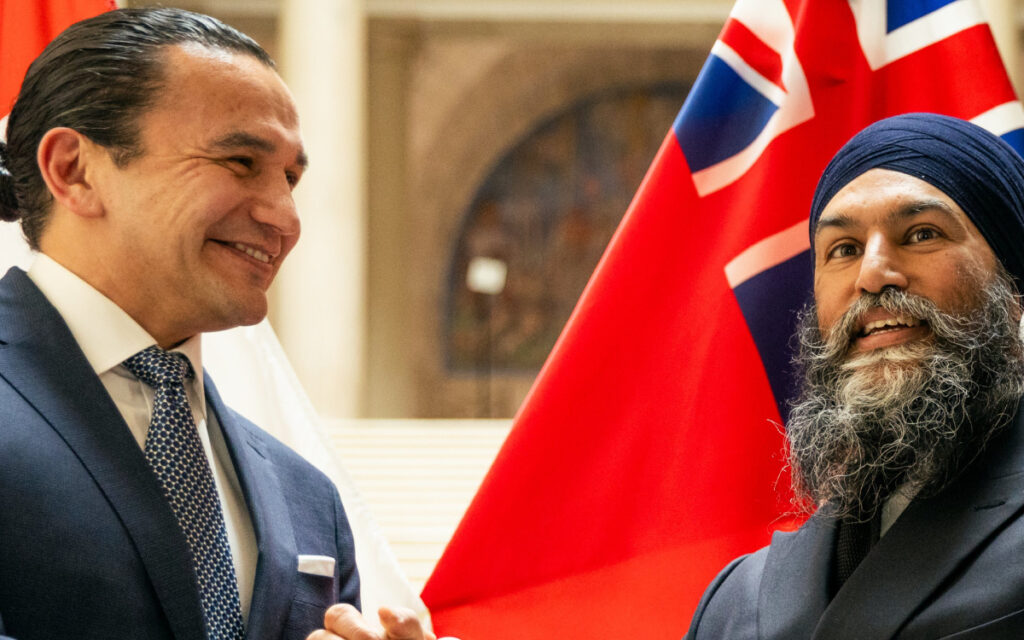
The backbench MP now makes three-and-a-half times more than the average Canadian. Cabinet ministers make more than five times, and the Prime Minister eight times that of the average Canadian. Pictured: NDP leader Jagmeet Singh with Manitoba Premier Wab Kinew. Photo Credit: Jagmeet Singh/X.
The recent news from Ottawa regarding the pay raises and the pensions of Members of Parliament was largely ignored in the subsidized legacy media except for concise file copy that reiterated government talking points. Canadians likely did not notice the MPs’ recent actions, having had their attention diverted to in depth coverage of the Baltimore bridge collapse and Donald Trump’s supposed “bloodbath” blasphemies.
What has transpired respecting MPs pay and pensions speaks volumes about the self-interests at play with the governing Liberal MPs and their enabling NDP MPs, and their combined steadfast commitment to see the life of this parliament extend to the full term of October 2025.
The pay hike
On Monday, April 1 all MPs were given their “automatic” (some legacy media term it a “customary”) pay raise according to a “Canadian Act of Parliament.” This year our elected representatives got pay hikes of 4.4 per cent, which equates to between $8,500 and $17,000 depending on their position.
Here is the math on this year’s pay hikes: Prime Minister Justin Trudeau’s salary is now $406,200, up from $389,200 in 2023; Cabinet ministers’ salaries are now $299,900 this year, up from $291,400 last year; Conservative Leader Pierre Poilievre is now paid $299,900 annually, up from $287,400 last year; NDP Leader Jagmeet Singh’s salary is now $271,700, up from $260,400 in 2023; and the base salary for all members is now $203,100, up from $194,600 last year.
If the MP holds a party parliamentary position, such as a house leader or whip, s/he gets an additional $36,000 to make their take home pay $239,100 this year. If the MP is a committee chair, s/he gets an extra $13,800 to boost their salary to $216,900.
MPs can expect similar raises in income on April 1, 2025.
As it is, MPs and Senators in a past parliament voted themselves a yearly pay increase. During the Jean Chrétien years, MPs passed legislation that established an annual pay increase that would be tied to the year’s average unionized private sector settlements. Each year a committee made up of cabinet ministers and senior opposition parties’ members meets behind closed doors and is tasked to review current statistics and settle the rate of increase for that year.
In essence MPs set their own pay increase, sidestepping any criticism by stating it is “the law.” It is now a given. Automatic. Consider that Canadians did not question parliamentarians when they took their annual pay hikes during the pandemic years of 2020-22!
Yet, when Canadians are feeling financially stressed and a growing number are lining up at food banks to make ends meet, when the Bank of Canada Governor instructs businesses not to raise wages in order to better control inflation, and when the Canadian economy is facing head winds challenged with a growing productivity gap with the U.S., one might expect our elected leaders to set an example and tighten their belts ever so slightly.
That did occur in the not so distant past. In the midst of the 2008-09 world financial crisis, the Conservative Government of Stephen Harper froze the salaries of MPs and Senators. The Harper government froze salaries for three consecutive years. However, even with this recent example, the Trudeau government made it clear that there would be no pay freeze this year.
In 2024, backbencher MPs now make $200,000-plus, cabinet ministers $300,000, and the Prime Minister north of $400,000. Based on Statistics Canada figures, this payola places Trudeau and his cabinet ministers in the top one percentile of income earners in Canada. MPs are within the top two percentile of Canadian income earners.
And the MPs’ largesse makes Canadian federal politicians the second highest paid elected representatives in the world. According to the data shared by PoliticialSalaries.com, Canadian MPs only rank behind the elected members of the U.S. Congress – just. American politicians make about $33,000 more. Other than that, Canadian MPs’ pay is considerably more than other similar democracies; consider members in the U.K. Parliament making 30 per cent less with a salary of $144,400.
The Canadian Taxpayers’ Federation (CTF) commissioned a poll to gauge where Canadians stand on MPs’ elevated salaries and their annual pay hikes. Not surprisingly, four of five Canadians (80 per cent) oppose the MPs cash grab, with almost two of three having strong opposition to it. According to Statistics Canada, the average take home pay for Canadians in 2021 was $56,935. So, the backbench MP now makes three-and-a-half times more than the average Canadian. Cabinet ministers make more than five times, and the Prime Minister eight times that of the average Canadian.
The pension
The other well-heeled shoe that dropped in late March had the Liberals tabling the new electoral reform legislation. Among the many significant changes to the rules around the next election, the Liberals and NDP have postponed the election date from October 20, 2025, to October 27, 2025. The rationale given was that the original voting day coincides with a Hindu religious holiday – but there is a much more compelling hidden reason for MPs to switch the dates.
By pushing election day a week later, MPs who were first elected on October 21, 2019, will then have a service record of six years and will become eligible to receive their parliamentary pension. This affects a total of 80 MPs: 32 Conservatives, 22 Liberals, 20 Bloc Quebecois, and six NDP MPs.
Though this benefits more Conservatives than other party MPs, it is mostly the Liberals and some NDP MPs who are at the greatest risk of losing their seat in the election – and therefore the individuals who are most wanting a pension to cushion their political retirement. For example, in the Niagara and Hamilton regions, of the class-of-2019 MPs, Niagara Falls Conservative Tony Baldinelli is heavily favoured to win and Hamilton NDP Matthew Green is polling ahead, but Oakville Liberal MP and senior minister Anita Anand trails badly in her race, and Milton Liberal MP Adam van Koeverden has only a 25 per cent chance of retaining his seat.
The Liberals and NDPs are vested in seeing the electoral reform legislation passed as quickly as possible to ensure the reforms are in place for the 2025 vote. Sun Media political newsman Brian Lilley made the quip that the country is now governed by “the pension coalition.” On this point, NDP Leader Jagmeet Singh is vested in maintaining the Liberal-NDP pact into next year – as his pension payout is also in play. Recall Singh won a by-election in February 2019, so he is eligible for a pension next February. The CTF has calculated Singh’s annual pension starting in 2034, when he is age 55, will be about $45,000 annually and he has the potential to be paid $2.3 million over his lifetime.
The CTF has also done the math on the starting pension ranges of $32,000 to $49,000 per year for the 80 MPs currently counting down the days, and Franco Terrazzano, CTF Federal Director, says: “If even half of these MPs lose, moving back the election one week would cost taxpayers tens of millions of dollars.”
In questioning the example MPs are setting with this move, Terrazzano comments: “When MPs tweak the system to pad their pockets, it sends a signal to thousands of bureaucrats that they should dig deeper into the trough too… Leadership starts at the top and MPs are going the wrong way.”
Last point regarding the pension matter is the simple comparison between MPs’ and the average Canadians’ annual pension. Blacklock’s Reporter reports that the pensions for retired MPs averaged $77,900 in 2023, up nearly 10 per cent in a couple of years since the pandemic, according to Treasury Board data. Statistics Canada and the 2021 Canadian Income Survey reveals the average pension income for retired couples is $69,900 and for individuals is $31,400. Not exactly comparing apples with apples, but one can discern the extra feathering in the MPs’ pension nests.
Given all these pay and pension numbers, Canadians can expect that, through to late October 2025, those Liberal and NDP “birds of a feather” will flock together.

Chris George is an advocate, government relations advisor, and writer/copy editor. As president of a public relations firm established in 1994, Chris provides discreet counsel, tactical advice and management skills to CEOs/Presidents, Boards of Directors and senior executive teams in executing public and government relations campaigns and managing issues. Prior to this PR/GR career, Chris spent seven years on Parliament Hill on staffs of Cabinet Ministers and MPs. He has served in senior campaign positions for electoral and advocacy campaigns at every level of government. Today, Chris resides in Almonte, Ontario where he and his wife manage www.cgacommunications.com. Contact Chris at chrisg.george@gmail.com.




















